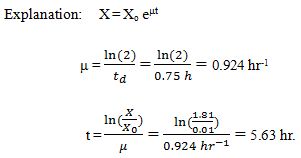This set of Bioprocess Engineering Multiple Choice Questions & Answers (MCQs) focuses on “Effect of Maintenance on Yields”.
1. Consider the growth of a microorganism in batch culture. When the substrate concentration is high, the cell density doubles every 0.75 h, the observed substrate yield coefficient is 0.3 g DCW/g, and substrate consumption is allocated towards biosynthesis (60%), maintenance (10%), as well as product formation (30%). The product formation is strictly growth-associated. The batch reactor is inoculated with 0.01 g DCW/L and 10 g/L substrate. Estimate the maximum cell density (after lag phase).
a) 1.21 g DCW / l
b) 1.41 g DCW / l
c) 1.61 g DCW / l
d) 1.81 g DCW / l
View Answer
Explanation: Xfromsubstrate = (10 g substrate/L).(0.6).0.3 g DCW/g Substrate = 1.8 g DCW/l
Xmax = Xo + Xfromsubstrate
= 0.01 g DCW/l + 1.8 g DCW/l
= 1.81 g DCW/l.
2. Refer to Q1 and, Estimate the time (after lag phase) required achieving it.
a) 5.60 hr
b) 5.61 hr
c) 5.62 hr
d) 5.63 hr
View Answer
3. Refer to Q1 and Q2, and determine the value of the maintenance coefficient (g substrate/g DCW-h).
a) 0.099 g substrate/g DCW-h
b) 0.089 g substrate/g DCW-h
c) 0.079 g substrate/g DCW-h
d) 0.069 g substrate/g DCW-h
View Answer
Explanation: 10% of the substrate goes to maintaining the cells.
m = (10 g substrate/l.0.10)/(1.81 g DCW/L.5.63 hr)
= 0.099 g substrate/g DCW-h.
4. Steady state condition is maintained in ____________
a) Continuous process
b) Batch process
c) Fed- batch process
d) Semi-batch process
View Answer
Explanation: In continuous process steady state condition is maintained, in which
– The rate of increase of cell biomass with time is equal to zero.
– The total number of cells are constant and
– The total volume in the bioreactor are constant.
5. What is the unit of Maintenance coefficient “m”?
a) kg substrate (kg biomass) S-1
b) kg substrate (kg biomass) S
c) kg substrate (kg biomass)-1 S-1
d) kg substrate (kg biomass)-1 S
View Answer
Explanation: A maintenance coefficient is used to describe the specific rate of substrate uptake for cellular maintenance, or
m = – [dS/dt]m/X
Unit of maintenance coefficient , m. is kg substrate (kg biomass)-1S-1.
6. “Ypx” is defined as mass or mole of product produced per unit mass or mole of substrate consumed.
a) True
b) False
View Answer
Explanation: (Ypx) is defined as mass or mole of product produced per unit mass or mole of Biomass formed.
7. The total mass and number of atom of each element these two quantities is constant during any Chemical and Biochemical reactions.
a) True
b) False
View Answer
Explanation: Total mass and Number of atom of each element
These two quantities are constant during any Chemical and Biochemical reactions.
Therefore the estimation of biomass can be done by using Stoichiometric calculations with the help of
– Biomass Yield
– Product Yield.
8. Reactant which controls amount of products is _________
a) Deficient reactant
b) Non- Deficient reactant
c) Limiting reactant
d) Excess reactant
View Answer
Explanation: The same thing happens in chemical reactions: there is always a limiting reactant, which is a chemical element or substance that limits the amount of product made during a chemical reaction. Typically, there is also an excess reactant, or the amount of an element or substance left over after the reaction stops.
9. There is always a limiting reactant.
a) True
b) False
View Answer
Explanation: If all the reagents are added in exactly the right mole ratio then all of each reagent is used up, so there is no excess or limiting reagent. In this case you can use either reagent moles to work out the amount of product formed. Then both reagents will be fully consumed so neither is limiting.
10. A homogenous material is defined as being ____________
a) An element
b) Any material with uniform composition
c) Synonymous with “solution”
d) Any material with non-uniform composition
View Answer
Explanation: “Homogeneous material” means one material of uniform composition throughout or a material, consisting of a combination of materials, that cannot be disjointed or separated into different materials by mechanical actions such as unscrewing, cutting, crushing, grinding and abrasive processes.
Sanfoundry Global Education & Learning Series – Bioprocess Engineering.
To practice all areas of Bioprocess Engineering, here is complete set of 1000+ Multiple Choice Questions and Answers.
If you find a mistake in question / option / answer, kindly take a screenshot and email to [email protected]
- Check Biotechnology Books
- Apply for Biotechnology Internship
- Check Bioprocess Engineering Books
- Practice Biotechnology MCQs

